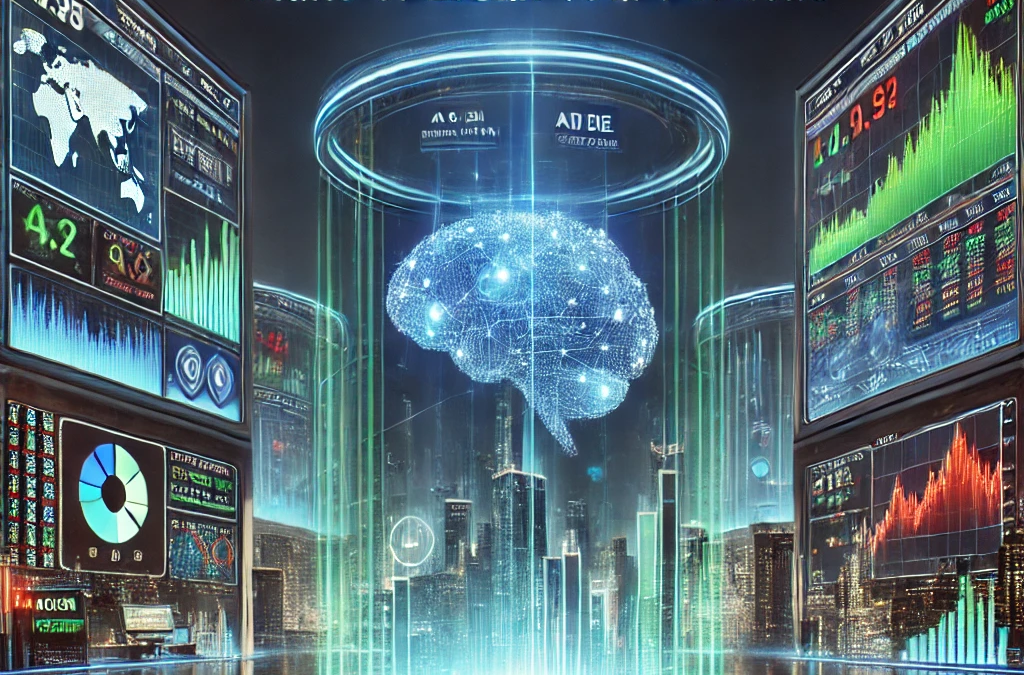AI’s Insider Edge: The Algorithmic Revolution That Will Make or Break Your Portfolio
In the fast-paced world of finance, staying ahead of the market has always been the key to maximizing returns. But with the rise of Artificial Intelligence (AI), the game is changing. AI is revolutionizing how portfolios are managed, introducing an algorithmic edge that can make or break your financial success. From lightning-fast trades to predictive analytics and personalized investment strategies, AI has the power to transform your portfolio’s performance in ways we’ve never seen before.
This article dives into the algorithmic revolution sweeping the financial markets, explores how AI can provide investors with an insider’s edge, and highlights the risks and rewards of relying on AI-driven strategies to build and manage your portfolio.
The Algorithmic Revolution: How AI is Changing the Game
The algorithmic revolution in finance refers to the widespread adoption of AI-powered algorithms to automate trading, manage risk, and predict market movements. Unlike human traders, AI algorithms can process vast amounts of data in real time, make complex decisions based on multiple factors, and execute trades at breakneck speeds.
These AI algorithms are reshaping portfolio management in several ways:
1. Data-Driven Decision Making
AI thrives on data. The more data it has, the better it can spot patterns, trends, and opportunities. In finance, this means AI can analyze historical prices, market sentiment, economic indicators, and even social media chatter to forecast market movements and make smarter investment decisions.
Key Benefits:
- Faster insights: AI processes real-time market data far quicker than any human trader can, enabling it to react to market shifts before humans have the chance.
- Complex analysis: AI can factor in multiple variables (such as market trends, company performance, and macroeconomic indicators) that are often too complex for human analysis.
Example: Hedge funds like Two Sigma and Renaissance Technologies are known for using AI to process vast datasets, identifying investment opportunities that are often hidden from human traders. Their AI-driven models analyze everything from historical prices to natural language data from earnings calls, news reports, and social media.
2. Algorithmic Trading: Speed and Precision
One of the most significant impacts of AI in finance is the rise of algorithmic trading—automated systems that execute trades based on predefined rules. AI-powered algorithms can make trading decisions within milliseconds, capitalizing on fleeting price discrepancies or market inefficiencies that would be impossible for human traders to exploit.
How AI-Powered Algorithmic Trading Works:
- High-frequency trading (HFT): AI algorithms can place thousands of trades in microseconds, profiting from small price differences that last for only milliseconds. This is a key strategy in high-frequency trading.
- Minimizing emotional bias: Human traders often make decisions based on emotion—fear in a downturn or greed in a bull market. AI algorithms remain emotionless, executing trades purely based on data and pre-set conditions, resulting in more disciplined and consistent strategies.
Example: Virtu Financial, a leader in high-frequency trading, uses AI algorithms to execute thousands of trades per second, profiting from small, short-lived market movements that human traders wouldn’t be able to catch.
How AI Can Give You an Insider’s Edge
AI’s ability to process data, identify patterns, and execute trades instantly gives investors a serious edge in the markets. But it’s not just about speed—AI provides insights and precision that allow for smarter, more informed investment strategies.
1. Predictive Analytics for Better Forecasting
AI’s predictive analytics capabilities are a game-changer for investors. By analyzing historical market trends, economic data, and even non-traditional data sources (such as news reports and social media sentiment), AI can predict future market movements with greater accuracy than human traders.
Why Predictive Analytics Matter:
- Risk management: AI can predict downturns before they happen, allowing investors to hedge their portfolios or exit risky positions before losses occur.
- Smarter asset allocation: AI’s predictive models can recommend how to allocate capital across different assets—stocks, bonds, commodities, or real estate—based on their expected future performance.
Example: Platforms like Kavout use AI-driven predictive analytics to assign a K Score to individual stocks, predicting which ones are likely to outperform the market. This allows investors to make data-backed decisions on where to allocate capital.
2. Personalized Investment Strategies
AI doesn’t just analyze market data—it also learns from your individual financial goals, risk tolerance, and preferences to create highly personalized investment strategies. This is particularly useful for investors who want a hands-off approach while still ensuring that their portfolio aligns with their long-term objectives.
How AI Personalizes Your Portfolio:
- Tailored asset allocation: AI analyzes your risk tolerance and financial goals (such as saving for retirement or growing wealth) and recommends a personalized portfolio designed to meet those needs.
- Automated rebalancing: AI can automatically rebalance your portfolio as market conditions change, ensuring your portfolio remains aligned with your target asset allocation without the need for manual intervention.
Example: Robo-advisors like Betterment and Wealthfront use AI to personalize portfolios for each investor, automatically rebalancing based on market changes and individual preferences. These platforms offer low-cost, automated portfolio management that continuously adapts to ensure long-term growth.
The Risks of AI-Powered Portfolio Management
While AI offers clear advantages in terms of speed, precision, and data-driven insights, it’s important to recognize that AI-driven investing isn’t without risks. Relying solely on AI to manage your portfolio can expose you to new challenges that human oversight might help mitigate.
1. Over-reliance on Algorithms
AI algorithms are only as good as the data and models they are built on. In some cases, over-reliance on algorithms can lead to unexpected outcomes, especially if the algorithms fail to account for external factors like political instability, natural disasters, or market manipulation.
Key Risks:
- Black swan events: AI may struggle to predict sudden, unexpected market events (like the COVID-19 pandemic), which can cause markets to behave unpredictably.
- Algorithmic bias: If the data used to train AI models is biased or incomplete, it can result in poor investment decisions or missed opportunities.
2. Flash Crashes and Market Volatility
While high-frequency trading driven by AI can increase market efficiency, it can also contribute to flash crashes—sudden, severe market downturns caused by automated trading systems acting on erroneous signals. In these situations, AI algorithms may unintentionally amplify market volatility, causing large-scale sell-offs that ripple through the market.
Example: The 2010 Flash Crash saw the Dow Jones Industrial Average plunge by nearly 1,000 points in minutes, largely due to automated trading algorithms executing massive sell orders in response to market fluctuations.
3. Lack of Human Judgment
AI excels at processing data and executing trades based on logic and models, but it lacks human intuition. Human traders often rely on judgment, experience, and an understanding of broader geopolitical or economic factors that AI might not fully account for.
While AI-driven systems are extremely efficient at executing trades and analyzing data, they may struggle with complex decision-making that involves subjective interpretation or longer-term strategic planning.
The Future of AI in Portfolio Management
AI’s role in portfolio management is only expected to grow in the coming years. As AI models become more sophisticated, they will enable even more precise, real-time insights, automated decision-making, and personalization for investors at every level.
1. AI and Quantum Computing
The rise of quantum computing will likely take AI-driven portfolio management to new heights. Quantum computers can process complex calculations exponentially faster than today’s most powerful supercomputers, enabling AI models to analyze even larger datasets and optimize trading strategies with unprecedented accuracy.
2. AI for Sustainable Investing
In the future, AI will play a key role in sustainable investing, helping investors align their portfolios with environmental, social, and governance (ESG) criteria. AI can analyze company practices, track sustainability metrics, and recommend investments in companies that meet specific ESG standards.
3. AI-Enhanced Robo-Advisors
The next generation of robo-advisors will be even more intelligent, using advanced AI to predict market trends, manage risk, and offer hyper-personalized investment strategies that dynamically adjust to each user’s evolving financial situation.
Will AI Make or Break Your Portfolio?
The algorithmic revolution driven by AI is reshaping the way we approach investing, offering investors unparalleled speed, precision, and data-driven insights. With AI, traders can process vast amounts of data in real time, make better-informed decisions, and execute trades faster than ever before.
However, relying solely on AI-driven strategies comes with risks, including over-reliance on algorithms and susceptibility to market volatility. To succeed in this new landscape, investors need to understand both the power and the limitations of AI. When used strategically, AI can provide an insider’s edge, allowing you to build a portfolio that outperforms the market. But as with any tool, it’s essential to strike the right balance between human oversight and algorithmic precision.
In the end, AI has the potential to make or break your portfolio—and whether you capitalize on it or fall behind depends on how you navigate this new financial frontier.




